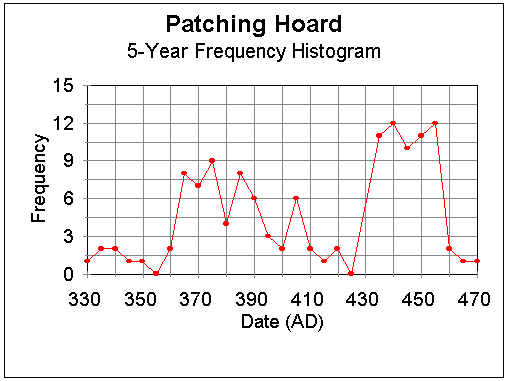 |
| TreasureRealm Home | The Patching Hoard | Other Countries | Coins for Sale |
The Patching Hoard
Details and Analyses
The coins span a period of 137 years from 333AD to 470AD; it is worthy to note that the Roman legions had withdrawn from Britain by 410. The bulk of the coins were minted in the Ravenna and Treveri mints, and a full third of the hoard consists of non-imperial, ie. Visigothic issues. Though 137 years in length, the bulk fall between the years 367 and 455, a period of 88 years.
This hoard contains what are thought to be the latest known roman coins found in Britain, only two or three of the hoards found in Britain in the past contain coins beyond Honorius (those of Constantine III). The Patching Hoard continues with coins from Valentinian III, Majorian and Libius Severus. A good percentage of the other hoards date from that period from 400 to 410 preceding the withdrawal of the Roman legions.
Though this hoard contains pieces minted as many as 60 years after the withdrawal of Roman troops, there should be little cause for astonishment. First, considering previous hoards, many consist solely of coins not struck at the Londinium mints. Therefore, it follows that coins traveled to Britain in trade or as payrolls. Similarly, none of the coins in the Patching Hoard was minted in Britain itself, either. The imperial mints at Londinium had ceased operating by 325 with a brief reactivation under Magnus Maximus from 383 to 388.
After the closure of the Londinium mints, the British began 'drawing' coins from the mints in Gaul and, as those closed, from farther south into Italy and to the East. This is seen in the Patching Hoard, the earliest coins (with the exception of 3 siliquae of Constantius II, Constans and Julian II which were struck 2 in Siscia and 1 in Antioch, respectively) are from Treveri (13) and date from 367 to about 392. 14 coins come from Ravenna and were minted from 430 to 455. This is interesting since Treveri ceased operations in 430. This closing must not have affected the inflow to Britain, since the later Ravenna pieces exceed those of Treveri.
The three coins of Constantius II, Constans and Julian II are also the earliest coins found in the hoard, dating from 337 to 363. In addition to those, there is a single miliarensis from Rome dating between 364 and 367. Mediolanum is represented by 3 coins dating from 378 to 402. The other multiple-coin mint found in the Patching Hoard is that of Constantinople, and this is represented by 5 coins dating from 408 to 441. The final mint is Arelate with a single Visigothic solidus of Majorian dating from 459-461.
This leaves 7 coins from mints that cannot be determined at this time owing to the lack of information.
A chronology of mints can then be put together as follows:
Mint Dates # Siscia (333-350) ( 2) Antioch (361-363) ( 1) Rome (364-367) ( 1) Treveri (367-392) (13) Mediolanum (378-402) ( 3) Constantinople (408-441) ( 5) Arelate (459-461) ( 1) ( 1 Visigothic) Ravenna (430-470) (14) (11 Visigothic) Uncertain ( 7) Total (47)
A chronology of Emperors is as follows:
Emperor Dates # Constantius II (337-340) ( 1) Constans (333-350) ( 1) Julian II (361-363) ( 1) Gratian (367-375) ( 2) Valentinian I (364-367) ( 1)* (possibly of Valens) Valens (364-375) ( 6)* Valentinian II (388-393) ( 2) Theodosius I (378-392) ( 4) Magnus Maximus (383-388) ( 2) Arcadius (388-392) ( 1) Honorius (395-420) ( 3) Theodosius II (420-441) ( 3) Constantine III (408-410) ( 1) Valentinian III (430-455) (13) (10 Visigothic) Majorian (459-461) ( 1) ( 1 Visigothic) Libius Severus (461-470) ( 1) ( 1 Visigothic) Uncertain ( 5) Total (48)*
A 5-year distribution plot over the range for which coins were minted is as follows:

| Solidi | Miliarensia | Siliquae | Total | ||||||||||||
| Tr | Md | Cons | Rv | Ar | Tr | Rm | Tr | Md | Sis | Ant | Cons | Rv | Unc | ||
| Constantius II | 1 | 1 | |||||||||||||
| Constans | 1 | 1 | |||||||||||||
| Julian II | 1 | 1 | |||||||||||||
| Gratian | 1 | 1 | 2 | ||||||||||||
| Valentinian I | *1 | *1 | |||||||||||||
| Valens | 1 | *1 | 4 | *6 | |||||||||||
| Valentinian II | 1 | 1 | 2 | ||||||||||||
| Theodosius I | 1 | 1 | 1 | 1 | 4 | ||||||||||
| Magnus Maximus | 1 | 1 | 2 | ||||||||||||
| Arcadius | 1 | 1 | |||||||||||||
| Honorius | 1 | 1 | 1 | 3 | |||||||||||
| Theodosius II | 3 | 3 | |||||||||||||
| Constantine III | 1 | 1 | |||||||||||||
| Valentinian III | 11 | 2 | 13 | ||||||||||||
| Majorian | 1 | 1 | |||||||||||||
| Libius Severus | 1 | 1 | |||||||||||||
| Uncertain | 1 | 4 | 5 | ||||||||||||
| Total | 3 | 2 | 4 | 12 | 1 | 2 | *2 | 8 | 1 | 2 | 1 | 1 | 2 | 7 | *48 |
News Release | Hoard Inventory | Details-Analyses | History

Custom Search
|
Terms of Use - Privacy Policy - Contact - Home
© 1996-2021 TreasureRealm